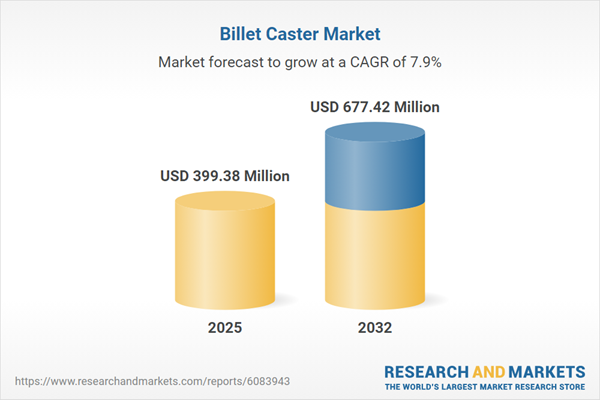Speak directly to the analyst to clarify any post sales queries you may have.
The Billet Caster Market is undergoing pivotal change, driven by rising supply chain intricacies, evolving regulations, and ongoing shifts in automation and process technology. Senior executives can use this report to navigate these complex dynamics, enhance decision-making, and identify actionable growth opportunities in global billet production.
Market Snapshot: Billet Caster Market Growth and Leadership Trends
From 2024 to 2025, the Billet Caster Market will grow from USD 369.67 million to USD 399.38 million, with projections reaching USD 677.42 million by 2032 at a CAGR of 7.86%. This robust expansion reflects a business environment adapting to sector modernization and realigned supply chains. Industry leaders are investing in advanced production technologies to assure consistent output even as they balance new trade policies that influence sourcing and global competitiveness. As a result, strategic priorities increasingly focus on efficient modernization and adaptive operations.
Scope & Segmentation
This comprehensive report equips industry leaders with a granular analysis of all key segments and forward-looking market shifts, supporting strategic planning and operational agility across the Billet Caster Market.
- Material Grades: Alloy Steel, Carbon Steel, and Stainless Steel each introduce unique performance and durability profiles, allowing producers to tailor output to end-use demands.
- End-Use Industries: Automotive, Construction, Manufacturing, and Oil & Gas each contribute distinct requirements that influence technology integration, throughput, and quality control.
- Caster Types: Both Curved Billet and Straight Billet options address needs for design flexibility, operational efficiency, and project-specific output.
- Output Capacities: High, Medium, and Low capacity operations cater to everything from large-scale manufacturing complexes to niche production for specialized projects.
- Automation Level: Fully Automatic, Semi-Automatic, and Manual solutions offer various combinations of speed, reliability, and operator engagement to meet operational preferences.
- Regional Focus: The Americas (encompassing North America and Latin America), Europe, Middle East & Africa, and Asia-Pacific—each region displaying distinct patterns in market maturation, capacity scaling, and technology uptake.
- Key Players Profiled: Industry leaders are represented through profiles on China Baowu Steel, ArcelorMittal, HBIS Group, Nippon Steel, POSCO, Anshan Iron & Steel, Shagang, JFE Steel, Shougang, and Tata Steel, lending a comprehensive perspective on global competitive positioning.
Billet Caster Market – Key Takeaways
- Technological progress, notably in automation and data analytics, is redefining how manufacturers approach production reliability, efficiency, and risk management.
- Material innovation remains essential, with manufacturers selecting specialized steel and alloy blends to satisfy the unique performance requirements of different industries.
- Policy uncertainty, including shifting tariffs, compels a reassessment of sourcing strategies and increases the emphasis on diversified supplier networks and regional resilience.
- Sustainability and process improvement initiatives are central, intersecting environmental responsibility with regulatory expectations and operational discipline.
- Collaborative development between suppliers, technologists, and end users is driving enhanced standards in product quality and workplace safety.
- Regional trends, such as continued infrastructure development in the Americas and high-volume production capabilities in Asia-Pacific, shape capital investment and customer engagement strategies worldwide.
Tariff Impact: Navigating U.S. Policy Changes
U.S. tariff implementations in early 2025 have hastened market transformation. Producers are adjusting sourcing, prioritizing diversification, and seeking supplier relationships outside traditional channels. Shifts in global trade have led suppliers to identify alternative growth markets, while producers focus on optimizing processes and controlling costs. These adaptations reinforce the need for flexibility in procurement decisions and capacity development planning.
Methodology & Data Sources
This assessment integrates thorough secondary research and detailed interviews with billet foundry executives, technical leaders, and key client representatives. On-site evaluations and quantitative modeling further substantiate findings, ensuring reliable perspectives on regional activity and technology trends in the global market.
Why This Report Matters
- Supports decision-makers by clarifying complex drivers, emerging risks, and key technologies with concise, actionable guidance.
- Enables robust strategic planning through detailed segmentation and scenario-based market forecasting, assisting with investment, sourcing, and adoption choices.
- Delivers perspective on major competitors, innovation trends, and regional market dynamics to inform market positioning and operational improvements.
Conclusion
Senior executives can rely on this report to navigate evolving innovation, policy, and value chain dynamics. The insights presented support durable, future-ready strategies for operational excellence and sustainable market growth in the Billet Caster Market.
Table of Contents
3. Executive Summary
4. Market Overview
7. Cumulative Impact of Artificial Intelligence 2025
Companies Mentioned
The companies profiled in this Billet Caster market report include:- China Baowu Steel Group Corporation Limited
- ArcelorMittal S.A.
- HBIS Group Co., Ltd.
- Nippon Steel Corporation
- POSCO Co., Ltd.
- Anshan Iron & Steel Group Corporation
- Zhangjiagang Shagang Co., Ltd.
- JFE Steel Corporation
- Shougang Group Co., Ltd.
- Tata Steel Limited
Table Information
| Report Attribute | Details |
|---|---|
| No. of Pages | 186 |
| Published | November 2025 |
| Forecast Period | 2025 - 2032 |
| Estimated Market Value ( USD | $ 399.38 Million |
| Forecasted Market Value ( USD | $ 677.42 Million |
| Compound Annual Growth Rate | 7.8% |
| Regions Covered | Global |
| No. of Companies Mentioned | 11 |









